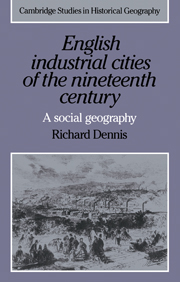Book contents
- Frontmatter
- Contents
- List of Figures
- List of Tables
- Preface
- A note on prices and distances
- 1 Urban geography and social history
- 2 Sources of diversity among Victorian cities
- 3 Contemporary accounts of nineteenth-century cities
- 4 Public transport and the journey to work
- 5 The geography of housing
- 6 Class consciousness and social stratification
- 7 The spatial structure of nineteenth-century cities
- 8 Residential mobility, persistence and community
- 9 Community and interaction
- 10 The containing context
- Notes
- Bibliography
- Index
9 - Community and interaction
Published online by Cambridge University Press: 05 January 2010
- Frontmatter
- Contents
- List of Figures
- List of Tables
- Preface
- A note on prices and distances
- 1 Urban geography and social history
- 2 Sources of diversity among Victorian cities
- 3 Contemporary accounts of nineteenth-century cities
- 4 Public transport and the journey to work
- 5 The geography of housing
- 6 Class consciousness and social stratification
- 7 The spatial structure of nineteenth-century cities
- 8 Residential mobility, persistence and community
- 9 Community and interaction
- 10 The containing context
- Notes
- Bibliography
- Index
Summary
A high rate of residential persistence within an area may be a prerequisite for the existence of geographically limited communities, but it clearly does not prove the existence of community consciousness.There may be other reasons for geographical immobility. Nor is it enough for neighbours to share the same occupational status although, in practice, ‘community’ - defined as people from the same area sharing the same attitudes, beliefs and interests, and expressing their communality of interest through social interaction - is most common where neighbours come from the same social class. ‘Community action’ is often a euphemism for ‘class action’, and ‘community’ equals ‘class consciousness’ in the language of many sociologists. Certainly, ‘community’ and ‘segregation’ were not opposites, as nineteenth-century observers imagined, but complementary. Residential segregation is devoid of meaning if the members of groups deemed to be segregated failed to interact or express common interests.
Community as social interaction may be defined through the medium of social network analysis, in which interpersonal relationships are measured in terms of their ‘density’ and ‘plexity’. Density refers to the interconnectedness of networks, whether they are close-knit or loose-knit; plexity measures the number of different roles in which individuals interact. Unfortunately, in dealing with historical communities we cannot reconstruct complete patterns of social contact for every dimension of every individual's social life. We can determine neither the plexity (because we do not know about every form of activity) nor the density (because we do not know about every individual) of past social networks.
- Type
- Chapter
- Information
- English Industrial Cities of the Nineteenth CenturyA Social Geography, pp. 270 - 288Publisher: Cambridge University PressPrint publication year: 1984

